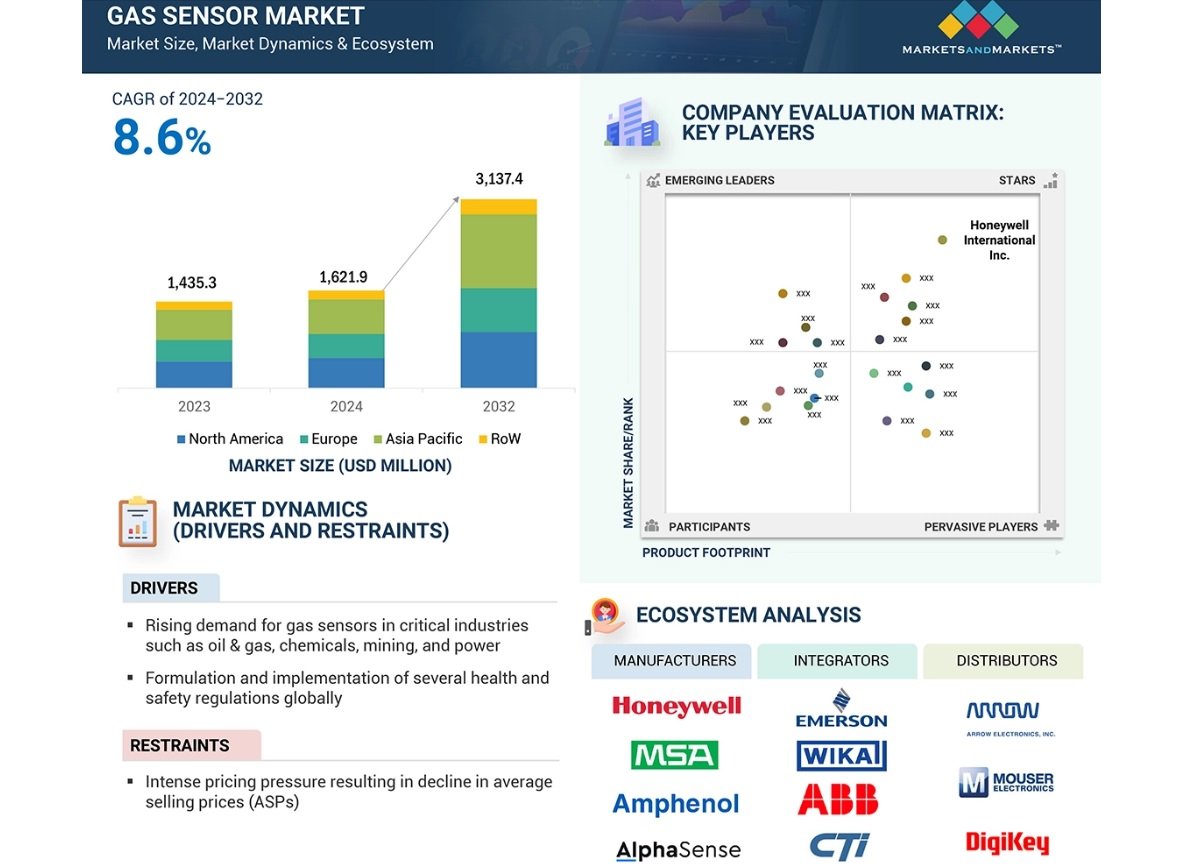Gas Sensor Market worth $3,137.4 million by 2032
The global gas sensor market is projected to reach USD 3,137.4 million by 2032, growing from USD 1,621.9 million in 2024 at a compound annual growth rate (CAGR) of 8.6%, according to a recent report by MarketsandMarkets™. The growth is fueled by increasing adoption across industries like oil & gas, chemicals, mining, and power, along with advancements in autonomous vehicles and IoT-enabled systems.
Key Drivers of Growth
Gas sensors play a vital role in monitoring hazardous gases, ensuring safety, and complying with environmental standards. Industries such as oil & gas and chemicals rely on these sensors to detect gases like methane and carbon monoxide, preventing accidents and adhering to strict regulations like OSHA and EU directives.
In the automotive sector, the rise in autonomous vehicles has driven demand for gas sensors that monitor cabin air quality, enhancing passenger safety. Additionally, IoT and smart technologies are enabling wireless gas sensors that offer remote monitoring and integration with digital systems, further expanding market opportunities.
Market Segments
Gas Detectors Dominate Product Segment
Gas detectors are expected to hold the largest market share due to their critical safety applications. Industries like oil & gas, manufacturing, and chemicals are adopting these devices to prevent accidents involving hazardous gases. Innovations like IoT connectivity have enhanced their functionality, boosting demand.
Wireless Connectivity Segment to Witness Highest CAGR
The wireless gas sensor segment is anticipated to grow rapidly, driven by demand for remote monitoring and ease of installation. These sensors facilitate real-time data transmission and predictive maintenance, addressing operational efficiency needs in smart buildings and industrial settings.
Air Quality Monitors to Lead in CAGR
Awareness of air pollution and its health impacts is propelling growth in air quality monitors. These devices are essential for monitoring pollutants in urban and industrial environments. Recent innovations, such as solar-powered wireless air quality monitors, highlight the focus on sustainable solutions.
Regional Insights
North America Secures Second Largest Market Share
North America, led by the U.S., accounted for the second-largest market share in 2023. Government initiatives targeting pollution control and HVAC adoption have bolstered growth.
Asia Pacific to Achieve Highest CAGR
Asia Pacific is projected to lead in CAGR, driven by increased adoption in automotive, consumer electronics, and industrial sectors. Countries like China, Japan, and South Korea are witnessing significant demand for gas sensors, particularly in automotive manufacturing and smart city projects.
Challenges and Opportunities
Development Complexities
Designing advanced gas sensors for diverse applications remains challenging due to high costs, time-intensive processes, and technical hurdles.
Emerging Opportunities in IoT and Cloud Integration
The integration of IoT, big data, and cloud computing with gas sensors offers transformative potential. These technologies enable real-time monitoring, predictive analytics, and improved operational control, creating opportunities for startups and established players alike.
Key Market Players
Major companies in the gas sensor market include Honeywell International Inc. (US), Amphenol Corporation (US), Sensirion AG (Switzerland), Figaro Engineering Inc. (Japan), and Infineon Technologies AG (Germany). These companies are focusing on R&D and partnerships to develop efficient and reliable gas sensors.
Conclusion
The gas sensor market's robust growth trajectory is driven by safety and environmental compliance requirements, coupled with technological advancements. Innovations in wireless connectivity and IoT integration position the market for sustained growth, particularly in sectors like automotive, smart buildings, and industrial automation. As environmental concerns intensify, the role of gas sensors in monitoring emissions and ensuring safety will become increasingly critical.
Read More
